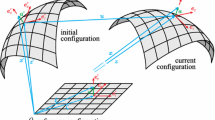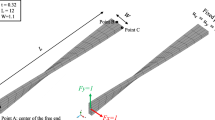Abstract
The peridynamic theory of solid mechanics offers an integral based alternative to traditional continuum models based on partial differential equations. This formulation is particularly advantageous when applied to material failure problems that result in discontinuous displacement fields. This paper presents a meshfree implementation of a state-based peridynamic bending model based on the idea of rotational springs between pairs of peridynamic bonds. Energy-based analysis determines the properties of these bond pairs for a brittle material, resulting in a constitutive model that naturally gives rise to localized damage and crack propagation.
















Similar content being viewed by others
References
Bessa M, Foster J, Belytschko T, Liu WK (2014) A meshfree unification: reproducing kernel peridynamics. Comput Mech 53(6):1251–1264
Foster J, Silling S, Chen W (2010) Viscoplasticity using peridynamics. Int J Numer Methods Eng 81(10):1242–1258. doi:10.1002/nme.2725
Foster J, Silling SA, Chen W (2011) An energy based failure criterion for use with peridynamic states. Int J Multiscale Comput Eng 9(6):675–988. doi:10.1615/IntJMultCompEng.2011002407
Fuller E Jr (1979) An evaluation of double torsion testing-analysis. Fract Mech Appl Brittle Mater ASTM STP 678:3–18
Moyer ET, Miraglia MJ (2014) Peridynamic solutions for timoshenko beams. Engineering 6(06):304. doi:10.4236/eng.2014.66034
O’Grady J, Foster JT (2014) Peridynamic beams: a non-ordinary, state-based model. Int J Solids Struct 51(18):3177–3183. doi:10.1016/j.ijsolstr.2014.05.014
O’Grady J, Foster JT (2014) Peridynamic plates and flat shells: a non-ordinary, state-based model. Int J Solids Struct 51(25):4572–4579. doi:10.1016/j.ijsolstr.2014.09.003
Sala M, Spotz WF, Heroux MA (2008) PyTrilinos: high-perfor-mance distributed-memory solvers for Python. ACM Trans Math Softw (TOMS) 34(2):1–33
Silling S (2000) Reformulation of elasticity theory for discontinuities and long-range forces. J Mech Phys Solids 48(1):175–209. doi:10.1016/S0022-5096(99)00029-0
Silling S, Epton M, Weckner O, Xu J, Askari E (2007) Peridynamic states and constitutive modeling. J Elast 88(2):151–184. doi:10.1007/s10659-007-9125-1
Silling SA, Askari E (2005) A meshfree method based on the peridynamic model of solid mechanics. Comput Struct 83(17):1526–1535. doi:10.1016/j.compstruc.2004.11.026
Taylor M, Steigmann DJ (2013) A two-dimensional peridynamic model for thin plates. Math Mech Solids. doi:10.1177/1081286513512925
Acknowledgments
This work was funded by grant number W911NF-11-1-0208 from the United States Air Force Office of Scientific Research.
Author information
Authors and Affiliations
Corresponding author
Rights and permissions
About this article
Cite this article
O’Grady, J., Foster, J. A meshfree method for bending and failure in non-ordinary peridynamic shells. Comput Mech 57, 921–929 (2016). https://doi.org/10.1007/s00466-016-1269-z
Received:
Accepted:
Published:
Issue Date:
DOI: https://doi.org/10.1007/s00466-016-1269-z




